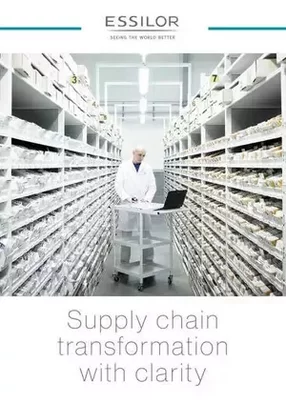Essilor: delivering the gift of sight through a robust supply chain transformation
80% of the sensory information that the brain receives comes via sight, making vision one of our most important senses. However, our eyes are complex organs and are rarely perfect: in fact, nearly two out of three people suffers from vision problems. The invention of lenses has been an invaluable aid, and with a streamlined, agile supply chain, Essilor, is ensuring that customers can get these vital solutions as quickly as possible.
Every day, Essilor manages more than 3,000 lens flows and over one million product references, relying on an expansive network of 34 production sites, 14 distribution centres and 481 prescription labs. This means that efficient supply chain management is crucial. One professional at the helm of this robust supply chain is Vladimir Zhirnov, Global Sourcing and Procurement Director of Supply Chain & Transport.
With over a decade of experience working at Essilor, Zhirnov has been there every step of the way as the firm has expanded its footprint through organic growth and local acquisitions. By drawing upon his expertise at Essilor from a local, regional and eventually a global level, Zhirnov says it’s given him “an entire understanding of how the company functions, what the current trends are, as well as the needs of different countries”. During this period, Essilor had to restructure its procurement and supply chain function to align it with the firm’s global vision. As a result, Essilor’s network footprint now able to support more than 2mn unique stock keeping units (SKUs).
A robust, data-driven supply chain
Digitalisation drives Essilor’s global supply chain which is dedicated to producing and delivering over 540mn lenses a year with a high degree of personalisation for individual wearers. Over the past two decades, Essilor has developed a robust digital backbone linking its ecosystem of production sites, prescription labs and distribution centres with over 350,000 customers, to its lens design, ordering and fulfillment systems. It’s a highly data-driven operation, requiring millions of rapid digital exchanges between customers and every part of the value chain from receiving prescriptions and fitting details to sending manufacturing instructions to a lab. To ensure optimal speed, performance and reliability, Essilor has migrated certain steps as cloud-based services, for example, a powerful calculator capable of generating lens designs to the more advanced personalized measures linked to the Group’s latest Varilux® X series™ progressive lenses. Essilor is already exploring the future of data-driven manufacturing with the creation of a concept Lab 4.0 at its Dallas campus, as well as exploring how artificial intelligence, machine learning, and collaborative robots can improve planning, production, and customer service.
The secret behind Essilor’s explosive growth lies in its commitment to R&D, with more than €200mn dedicated each year to research and innovation. This allows the firm to offer exclusive products that distinguish it from its competitors, but with swathes of customised products comes more logistical challenges. This is where Essilor’s world-class supplier network lends a helping hand. “We have more than 30,0000 suppliers, of which 1,000 are logistics and supply chain vendors,” explains Zhirnov. “We classify these suppliers into three grades whereby we have 14 strategic vendors, 500 preferred vendors and the rest classified as others.” With such a complex network of partners, supplier relationship management is critical and as such Essilor has developed a thorough relationship management program which ensures that its strategic vendors have a mutually beneficial partnership. “It helps us understand what the partnerships are going to achieve, what our plans are, and how we can support each other to complete these missions,” he says.
But why is supplier sustainability so important for Essilor? “We believe that if we work hand in hand with our suppliers, together we can increase the positive impact of our business in the communities where we work,” notes Zhirnov. “For the past two years in our Sourcing and Procurement team, we’ve set out to involve our network of suppliers in different ways. In addition to driving compliance with Essilor’s responsible business practices, we engage suppliers in three key areas: promoting visual health through awareness raising and screening actions; responsible sourcing from economically vulnerable populations; and positive environmental initiatives through sharing best practices and implementing eco-responsible approaches.”
A global powerhouse, with regional expertise
As is the case for any procurement or supply chain professional, managing costs is a key consideration for Zhirnov and his team. To tackle this, Essilor has developed a shrewd strategy to drive down freight costs in the form of regional docking hubs. In essence, this means that all products heading to Asia, for instance, have one point of arrival by air freight. They are then distributed by road and air within the continent with help from local or regional partners. “The concept is that we are entering one continent by air freight at one point and then we are leveraging our partners to distribute our products throughout the country,” Zhirnov says. “If you have 30 plants and you are sending products to smaller markets, Malaysia for example, it’s quite costly to continuously feed into the country directly from across the global plants. Therefore, we send upstream shipments to our regional docking hubs and distribute products from there.”
Similarly, Essilor distributes all its Middle Eastern products from Dubai and all its European products from Paris. Employing over 67,000 people and developing its production and logistics footprint globally, this extensive presence is a key accomplishment for the firm. “We’re really helping to contribute to skills development in different countries,” Zhirnov says. Today, Essilor has a global footprint spanning around 100 countries and as it continues to grow this logistical challenge will only get greater. A key factor for Zhirnov is ensuring regional needs are being met and this is in part achieved by giving employees a voice – 65% of employees are shareholders and around 4% of the Group’s capital is held by employees who are also involved in the company governance. “This decentralised decision-making offers us transparency and the responsiveness to different regions,” he explains.
Concentrating its efforts
As well as selling a variety of lenses, Essilor has also claimed a portion of the consumables market – providing vital tools and items needed to solder parts and edge lenses, for example – but this hasn’t come without its challenges. In the US market, for example, there were several players within the group competing for a slice of the pie which threatened Essilor’s margins. By working closely with a third-party logistics (3PL) network design consultant, however, the firm has found data analytics to be a useful tool to tackle this hurdle. “We analysed all the inbound data, the sourcing data, and the customer-based data to identify our core areas in the US,” reflects Zhirnov. By redesigning its consumables network, Essilor reconfigured its distribution centre locations in the US and focused its efforts on areas where it was needed most. This helped to drive labour, capex rationalisation, reduce freight costs and more. “It offered us better costs, lower investments and at the same, it ensured we designated channel champions so to avoid competing against each other.”
A historic merger
Another project which Zhirnov has a keen eye on revolves around the company’s merger with Italian eyewear company Luxottica, which owns brands including Ray-Ban, Oakley and Sunglass Hut. This will not only propel Essilor’s and Luxottica reach farther into the various markets, but it will also undoubtedly impact the firm’s sourcing logistics and supply chain. Although this deal is still in its early stages, there’s a lot to consider. “Essentially, the supply will be doubled and we’ll also have two different systems and organisations that needs to be combined”, Zhirnov observes. So whilst this transition is in its early stages, Zhirnov is confident that the integration will be seamless.
Knitted into the fabric of Essilor’s core mission is its sustainable approach, and this hasn’t gone amiss when it comes to the company’s supply chain and logistics management. As part of its 2020 sustainability strategy, 100% of Essilor’s strategic suppliers will receive an external CSR audit and 100% of its preferred supplies will acknowledge Essilor’s Supplier Charter. “As part of this, we ensure that the materials we are buying are not manufactured through child labour and don’t come from regions where minerals are extracted in an improper way,” Zhirnov adds.
On top of this, the firm has also set itself another impressive task: to eradicate poor vision by 2050. “It’s the most honourable part of why we go to work every day,” asserts Zhirnov, pointing out how 2.5bn people still lack vision correction today. Through forging partnerships with NGOs, national governments and the private sector as well as facilitating the development of local social entrepreneurs networks, Essilor hopes to understand local needs and barriers so that it can create vision care infrastructure that is both purposeful and sustainable. In the coming years, Essilor may grow its supply chain and procurement function further, but it seems the top item on Zhirnov’s agenda can be best summarised by the firm’s mission: “improving lives by improving sight”.



- WATCH: Ivalua and PwC Navigate the Future of ProcurementProcurement
- Could Schneider’s Offshore Charging Transform Shipping?Sustainability
- Top 10: Women in Supply Chain and Procurement in APACProcurement
- Dumarey Streamlines Suppliers with BearingPoint and JAGGAERSupplier Relationship Management (SRM)

